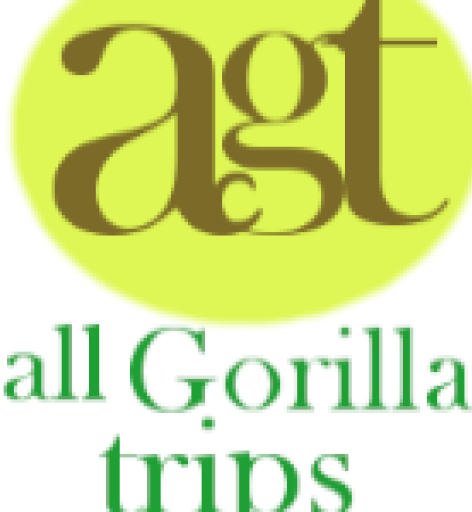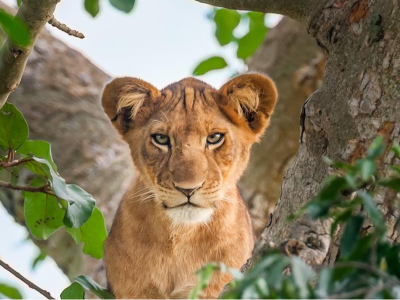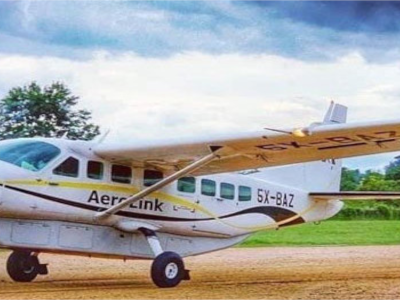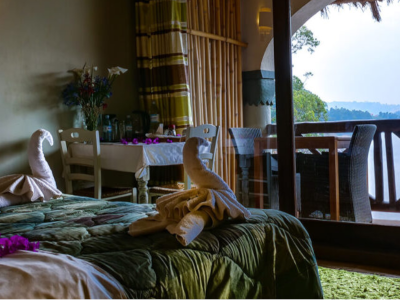Enjojo lodge
Enjojo lodge
Enjojo lodge
Enjojo lodge is both budget and mid-range accommodation found in the gates of the Ishasha sector (2km outside the gate) in Queen Elizabeth national park in western Uganda near the historical town of Fort portal in districts of Kasese, Kamwengye, Rubirizi, and Rukungiri. The lodge was named Enjojo because, during the construction of the lodge, there was the birth of many elephants in the area. The park occupies the total area 1,987 km squared You can be at the lodge by either road or air transport . its approximately 6-7 hour drive(410km) from Kampala City to the park and 2 hours and 30 minutes flight from Entebbe to the nearby airstrip in Queen Elizabeth by Aero link.
Enjojo lodge consists of 16 beautiful rooms in different categories of grass-thatched cottages, safari houses suitable for families, bamboo huts and canvas tents along with good camping ground where travelers on Camping safaris in Uganda can pitch their tent. Cottage rooms are well furnished with privacy and tranquility. Each cottage room has en-suite private facilities like flushing toilets, mosquito nets, and hot running showers and tents offers outdoor showers
Campers can also use our outdoor showers made of rocks and clean toilet facilities. Rooms have verandas and sitting areas, you relax while enjoying the good breathtaking view of African wilderness and the surrounding area. Excellent and comfortable beddings. There are fireplaces at the lodge that provides warmth to visitors staying at the lodges.
Queen Elizabeth National Park
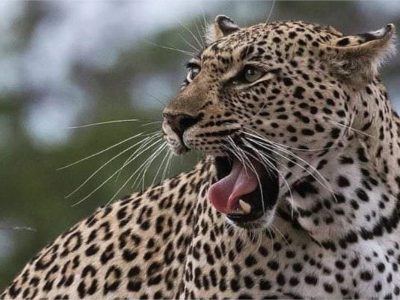
Queen Elizabeth National Park
Queen Elizabeth National Park is 1978 square km; has 57 vegetation types but it is mostly open savannah with acacia and euphorbia it also includes extensive wetlands and a huge tract of tropical forest; supports 612 bird species (only Virunga NP) has more in Africa including 54 raptors; home to 95 mammal species including around 2,500 elephants, 20 different predators with 200 lions (40 tree-climbing lions in Ishasha); supports 10 primate species including chimps in Kyambura gorge and Maramagambo Forest; good for Uganda Kob, large herds of buffalo, giant forest hog, waterbuck, topi, hyena, and crocodile. Leopards are seen quite regularly.
Queen Elizabeth is fairly small but it holds a lot of diversity and should really be looked at in distinct chunks to get a proper appreciation for what it has to offer. The park itself is part of a much larger conservation area including the Rwenzoris, Kibale Forest, Virunga National Park and Kigezi / Kyambura.
The entire park is divided north from south by the Kazinga Channel, a 40 km long channel of water flowing gently from Lake Gorge in the east to Lake Edward in the west.
The northern area features the Kasenyi plains (with a good game viewing network) in the east towards Lake Gorge;the Explosion craters in the west towards Mweya Lodge and Lake Edward.
The Mweya Peninsula on the northern bank of the Kazinga Channel at the confluence with Lake Edward is the main safari attraction in the north. To the south, Kyambura Wildlife Reserve is in the east on the edge of Lake Gorge, the main attraction is Kyambura Gorge.
Maramagambo Forest and Kigezi Wildlife reserve are in the east of the southern sector. The Ishasha plains are in the south bounded by Lake Edward and the Ishasha River on the DRC border. The area boasts a tropical climate with temperatures never rising above 30 or dropping below 16 degrees centigrade.
Activities in Queen Elizabeth National Park
Mweya and Kazinga Channel
The Mweya peninsula is the focal point of the northern sector and has a great location with excellent views across the Kazinga Channel towards the Rwenzoris. The Mweya Information centre has guides with whom nature walks are possible - $10 for a few hours.
The Kazinga Channel launch cruise along the shoreline at 0900, 1100, 1500 and 1700 hours to get a close up view of good resident game (particularly hippo, buffalo, elephant) and fairly prolific birdlife including lots of water fowl. The launch cruise runs clockwise down the southern bank towards Lake Edward and returns back on the northern bank - try and get a seat on the left side or find a spot on the top deck.
Wildlife Safari in the northern circuit
A fairly good road network runs parallel with the Kazinga Channel- a fair area for game viewing, apparently one of the few places where the giant forest hog are regularly seen during the day.
The west of the main road includes the "Explosion Craters" with a large cluster of 7 crater lakes and dry calderas. Lake Nyamunuka is clearly visible from the main road into the park - usually good for buffalo. The area is generally good for elephant herds in the dry season.
To the east of the main road includes the Kasenyi Plains which has the largest concentration of game in Queen Elizabeth NP. The area includes a large breeding ground for Uganda Kob and is also good for buffalo, lion and grassland birds. There is a substantial breeding population of shoebillin the Kikorongo swamp.
Kyambura Gorge
The Kyambura river cuts 100m chasm for about 16km through the sorrounding savanah as it runs towards Kazinga Channel and forms the eastern boundary of QENP. The gorge protects an isolated patch of riparian forest including a habituated population of chimps.
Success rates for viewing are quite high at around 80% and the forest is good for birds and the guiding is of high standard. Only 8 permits are available for either 0800 or 1300 treks which last around 2 -3 hours.
Permits should be booked in advance and cost $50 each. The habitats of gorge includes red tailed, vervet, balck and white colobus monkeys, olive baboons and giant forest hog. The gorge rim itself and Fig tree camp is about 3 km from the main road, about an hours drive from Jacana Lodge or Mweya Lodge.
Maramagambo Forest
Maramagambo is one of Uganda's largest tropical forests. Noted for it's rich diversity of forest birds and primates including a strong population of un habituated chimps, Maramagambo Forest is relatively undeveloped yet readily accessible (about a kilometre away from Jacana lodge).
Different guided walks are available from simple nature trails with the opportunity to visit the bat caves (home to several thousand Egyptian fruit bats) to the full day walking trails with a focus on the forest and its birds. A full day guided trails costs US$10.
Ishasha Plains
The southern sector is bounded in the west by Lake Edward and the Ishasha River on the border with DRC. The area has 2 main game driving
circuits. Southern circuit is where the main kob breeding grounds are found and is best known for the 40 odd tree climbing lions that frequent clusters of sycamore figs and albizias. The northern circuit passes through the Lake Edward flats, a good area for general game viewing and a fair chance to see the shoebill. The road in the northern circuit can
be very dodgy after rains.
The Ishasha River has a well established camp site set in good forest, particularly good for bird watching. Ishasha wilderness Tented camp on the Ntungwe River is the best base from where to explore the area.
Elephants are surprisingly good in Ishasha - there is a big herd of around 80 or so individuals on the southern circuit.
Read more
